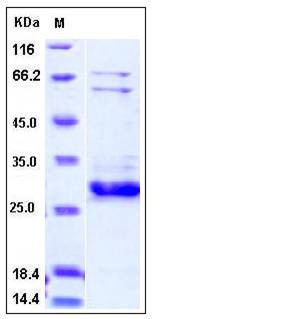Human XIAP / BIRC4 Protein (AVI Tag)
API3,BIRC4,hIAP-3,hIAP3,IAP-3,ILP1,MIHA,XLP2
- 100ug (NPP4400) Please inquiry
| Catalog Number | P10606-H17E |
|---|---|
| Organism Species | Human |
| Host | E. coli |
| Synonyms | API3,BIRC4,hIAP-3,hIAP3,IAP-3,ILP1,MIHA,XLP2 |
| Molecular Weight | The recombinant human XIAP comprises 253 amino acids and has a predicted molecular mass of 29.1 kDa as estimated in SDS-PAGE under non-reduced conditions. |
| predicted N | Met |
| SDS-PAGE |  |
| Purity | > 75 % as determined by SDS-PAGE |
| Protein Construction | A DNA sequence encoding the human XIAP (NP_001158.2) (Leu 121-Thr 356) was fused with an AVI tag at the C-terminus, and additonal two amino acids (Gly & Pro) at the N-terminus. |
| Bio-activity | Measured by its binding ability in a functional ELISA. Immobilized recombinant human SMAC-His (P10339-H08E)at 10 μg/ml (100 μl/well) can bind recombinant human XIAP-AVI (P10606-H17E) with a linear range of 0.125-1.0 μg/ml. |
| Research Area | Signaling |Signal Transduction |Cytoskeleton / ECM |Cytoskeletal Proteins |Microfilaments |Actin etc | |
| Formulation | Lyophilized from sterile 25mM Tris, 10mM DTT, 1% glycerol, 0.2M Glutamine Potassium, pH 8.0 1. Normally 5 % - 8 % trehalose, mannitol and 0.01% Tween80 are added as protectants before lyophilization. Specific concentrations are included in the hardcopy of COA. |
| Background | E3 ubiquitin-protein ligase XIAP / BIRC4, also known as inhibitor of apoptosis protein 3, X-linked inhibitor of apoptosis protein, and IAP-like protein, is a protein that belongs to a family of apoptotic suppressor proteins. Members of this family share a conserved motif termed, baculovirus IAP repeat, which is necessary for their anti-apoptotic function. XIAP / BIRC4 functions through binding to tumor necrosis factor receptor-associated factors TRAF1 and TRAF2 and inhibits apoptosis induced by menadione, a potent inducer of free radicals, and interleukin 1-beta converting enzyme. XIAP / BIRC4 also inhibits at least two members of the caspase family of cell-death proteases, caspase-3 and caspase-7. Mutations in this encoding gene are the cause of X-linked lymphoproliferative syndrome. Alternate splicing results in multiple transcript variants. Thought to be the most potent apoptosis suppressor, XIAP / BIRC4, directly binds and inhibits caspases -3, -7 and -9. Survivin, which also binds to several caspases, is up-regulated in a many tumour cell types. Defects in XIAP / BIRC4 are the cause of lymphoproliferative syndrome X-linked type 2 (XLP2). XLP is a rare immunodeficiency characterized by extreme susceptibility to infection with Epstein-Barr virus (EBV). Symptoms include severe or fatal mononucleosis, acquired hypogammaglobulinemia, pancytopenia and malignant lymphoma. |
| Reference |
